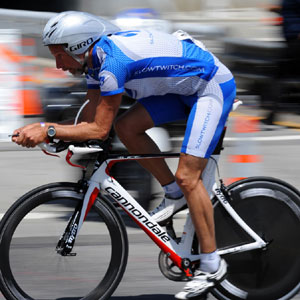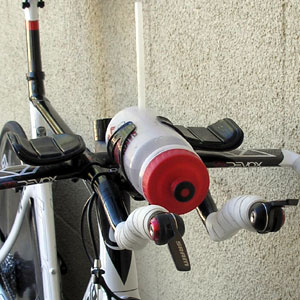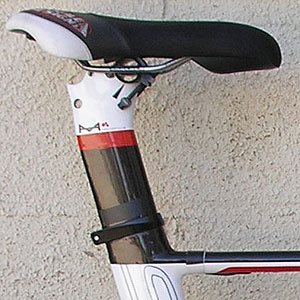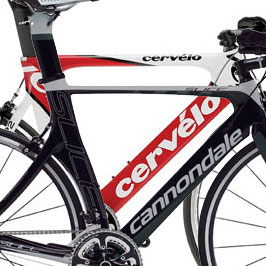The final Slice

As many Slowtwitchers know, the Slice I rode in the Tour of California time trial did not deliver me safely to the finish line. Nevertheless, I did promise readers a recap of that Slice, as I rode it, as it was set up.
Before I commence with my final comments about this Cannondale Slice, I think it important to note that the Slice performed as requested. I asked the bike to deliver me over a manhole cover sunk several inches below the surface of the road. The bike faithfully executed my request. Had the Slice the ability to emote, I'm sure it would have been as disappointed as I that it was not allowed the opportunity to demonstrate its abilities over the entire length of the event.
Point is, my crash at mile-8 or mile-9 was entirely pilot error, and no fault of the bike. I spoke to one other competitor who was likewise taken down in the race by a manhole (a different manhole). My advice: If you see one of these in L.A., negotiate around it.
MAKING IT FIT
As chronicled in a prior article, I had the math worked out in advance. For those who do not know, or have not yet investigated, we at Slowtwitch have constructed an elegant set of solutions that solve the questions of spatial relationships between fit coordinates, and how you transfer or normalize between frames and aerobars of various geometries.
Simply put, my best "on paper" geometry is moderately long and low, such as what you'd find in the Cervelo P3 I typically ride. The Slice is moderately narrower/taller, and this means the head tube top is not as far out in front of the BB as on my P3, and that head tube top is taller above the BB than on my P3.
So, I needed an aerobar that featured armrests that sat lower relative to the pursuit bar's centerline. I had a few options. I could have used a Visiontech clip on. I could have used a HED one-piece. I could've used a Profile Design CX3. All of these bars, and more, would've worked and, by "worked" I mean the armrests could sit no higher than, max, 3cm above the handlebar clamp (a term I use interchangeably with "centerline of the pursuit bar").
Likewise, I could've used a Felt Devox, and I chose this bar, for three reasons. First, I had one of these aerobars in my workshop already. Second, it's probably the lowest profile of all the aerobars mentioned above, and, I knew getting the aerobars low enough was going to come down to millimeters, and I needed every bit of "lowness" I could get. Third, I'd already mounted these bars on one of my fit bikes and ascertained that it was quite comfortable.

Finally, I used the Devox bars because I needed a pursuit position that did not debase in elevation my contact points, and because these contact points were not pitched far in front of the handlebar clamp. Let me restate: I wanted a pursuit position that did not thrust my hands way forward, nor place them well below the handlebar clamp, such as what you might think you want for sprinting. This, because this bike is already a slight bit slow in handling at 62mm of trail (which I like), and every extra centimeter of forward protrusion, or descent in elevation, adds to the slowness of steering. A flat (level), close-reach pursuit bar, in combo with this bike's geometry, was what I wanted, and it's what the Devox delivered.
But I did make one change. I swapped in a Blackwell Wrist Relief extension. There's nothing wrong with the Felt extension, it's well conceived. Just, for a variety of reasons described in part-1 of this series, including an arcane type of water bottle mount I intended to use, I felt I needed to use an extension I knew in advance would work.
MAKING IT COMFORTABLE
I had a top pro female in my fit studio yesterday, and I told her then what I'll tell you now: I can't even start to execute a bike fit on you before we solve contact point problems. If your saddle isn't comfortable; if your aerobar pads aren't comfortable; if you don't have extensions that match, in elevation, the plane of the armrests; if your extension contact points (where your hands grip the aerobars while in the aero position) aren't angled to match your desired ergonomics; then we're pissing up a rope trying to find your proper fit coordinates.
I rely on my own advice in that regard. I can't ride my fit coordinates unless my contact point problems are solved. In fact, think about this: I have two tri bikes at the moment, a P3 and a Slice. But each features the same saddle, and the same aerobar extensions. Really, my "inputs" seem to be these comfort items, don't they? It's like the guy who's on his third wife and first dog. When push comes to shove, The dog was here first. Likewise the saddle. The dog, and the saddle, are inputs.

In my case, the saddle is a Profile Design TriStryke. Yet I must say that I found a saddle I like better. It's a prototype made by George Yates. George and I met while competing at the 1981 Hawaiian Ironman. In 1987 we each started manufacturing companies. Mine was Quintana Roo, George's was Trico Sports. If you tote your bike around in an Ironcase, George makes that. He also makes saddles and seat pads. He made me a prototype saddle that I just love. When it's out and for sale, I'll write about it.
MAKING IT HYDRATE ME
There is no more Blackwell Products, alas. But I'm "archiving" a Blackwell stash, into which goes two items that I admire: Wrist Relief extensions (a little birdie told me that John Cobb may be of help if you need to acquire these); and the plate onto which the Blackwell clip-on armrest cups mounted. This plate I use for fabricating a little between-the-armrest bottle holder.
On to this mounts a water bottle cage, and, into the cage I stick a bottle. I drill a hole in the side of the bottle just smaller than the diameter of a stiff vinyl tube out of which I'll drink (this hole now sits on top of the bottle once the bottle is mounted sideways into the water bottle cage). Then drill little tiny holes in the side of that vinyl tube near its base, so that when you suck you get water.
It's not refilliable. But then I don't race long, and, if I do race long enough for subsequent bottles, I'll toss this bottle once it's empty and then stick into my holder a standard bottle. Yes, I'll have to take this aid station bottle out of the cage and drink from it normal-wise, which is not as aero as my seat-of-the-pants system described here, but, bottles placed in this position on the bike are pretty convenient to get at.

Now, you might say, "Why do you need a bottle for a 21-mile TT?" Answer: I might not need to drink, but I like to drink. I don't like to ride thirsty. So sue me. To those you disagree, heed the admonition of the most interesting man in the world: Stay Thirsty My Friends.
MAKING IT STOP
This bike, as noted in my previous installment, came with mostly SRAM Rival components. This included brake calipers. For this course, I knew I might have to brake several times, because there were ascents and descents, and lots of corners. Most of the corners I could either coast or corner through. But for the few at the bottom of descents, or, for tighter radius turns, having good brakes and braking surfaces is really an overlooked enhancement to your speed. The later you can wait before executing a deceleration, the less time you lose.
So, I slapped on a set of Campagnolo Record brake calipers. It's true that these calipers don't have a spreading mechanism. But, the wheels I intended to use had fairly wide rims, and the width of the tire was barely greater than that of the rim. So, I really didn't have to worry about spreading the calipers to get the wheels in and out.
MAKING IT CORNER
This 58cm bike was delivered to me with an FSA crankset in a 175mm length, spec'd with 53×39 chainrings. I wanted shorter cranks, for reasons not all of which I'll go into now (but which I have gone into here). One reason was the ability to pedal through corners. For this race, I had the entire road most of the time, which makes this very different from triathlons, where you have part of a lane.
So, the tactical and technical elements of this race gave me the freedom to spec a bike with pedaling through corners achievable. Cervelo's bikes are already made with this in mind or, at least, with this as a by-product of their designs. The bottom brackets sit 6cm below the wheelbase line and, while this may (or may not) be marginally detractive to the aerodynamics and handling of the bikes, it does make it easy to pedal through turns. The Slice's BB sits 7.2cm below the wheelbase line, so, the 170mm cranks made it easier to contemplate pedaling through corners while in the aero position.

I stuck on there an FSA SLK crankset made for BB30 bottom bracket shells. BB30 is an open platform bottom bracket standard, first introduced by Cannondale about a decade ago, and gaining in acceptance. The "30" in BB30 refers to to the diameter of the oversized bottom bracket axle. I chose a standard bolt pattern (130mm) 53×39 chain ring spec. The crank was easy to install, shifted perfectly, no problems.
You're in a vulnerable spot, pedaling through a turn in the aero position, but, on this course, on this bike, these cranks, with Look Keo pedals (I'm a Keo fan), I pedaled through all but 2 or three of the turns I encountered in my three-fourths of a lap.
MAKING IT SHIFT
The Slice also came with SRAM's return-to-center shift levers and an 11-25 cassette. But I chose not to use these levers. I only had 3 or 4 rides available to me on this bike before racing, and I was well acquainted with SRAM's standard bar end shifters, and I had an extra set of these, so I used them.
SRAM was strategic in its approach to triathlon. While obviously the johnny-come-lately to the components game, SRAM was the first of the big-3 component companies to come out with a dedicated bar-end shifter (not a reclaimed thumb-shifter), and a plug-in brake lever. So, in a way, SRAM leapfrogged over Campy and Shimano in its offerings to triathletes. This, right when the triathlon market was proving its worth as a bona fide financial category to the cycling world.
Here's the strategic benefit to SRAM: while its derailleurs shift no better than Shimano's derailleurs, the shifters are much better than Shimano's bar-ends, so, it makes the entire shift system seem better. The rider can't tell what's better—the shifters, derailleurs, cogs, chain rings, or chains. All he knows is that SRAM-outfitted bikes shift crisper and smoother than Shimano-spec'd bikes. But in point of fact, it's only the shifter that is an intrinsically better part. This, at least, is how it seems to me, after riding considerably on both drive trains.

MAKING IT AERO
My reticence to riding a disc in the rear was all the turns, and to the very rough road surface. I needed a rear wheel that absorbed road imperfections, so I could hang onto the road surface during the turns I intended to take at a relatively high speed, and to stave off pinch flats, bent rims, and so forth, depending on what imperfections I rolled over.
A happy medium is the HED Jet disc, a high performance, permanent wheel cover attached to an otherwise spoked wheel. I paired that with a front Jet in a 60mm depth.
I borrowed a Giro aero helmet from Paul Thomas, which fit perfectly, and also worked nicely when I crashed. My head was one of the "contact points" and even as it was smacking the pavement I remember thinking right at that moment, "How nice that these aero wheel flaps are protecting my ears from getting chewed up."
MAKING IT ROLL
I decided to ride clinchers, and fortunately the wheels I had were clinchers (well, the HED Jet disc was mine, I borrowed the Jet 60 from Monty). I already had some Vittoria Evo CX tires in 23mm, and these are quite fast. I've had a lot of good luck with these.
What I didn't have were latex tubes. I called around everywhere, and couldn't find any. "Note to self," thought I just before the TT: When this is all over, tell Slowtwitchers (and in so doing the companies who monitor Slowtwitch) that we need some more latex tubes!
So I rode butyl tubes. The disc required for inflation a hash pipe (which I had), and the HED Jet 60 with the straw for inflation (which I had). Remember to Teflon tape the valve core threads before screwing on the straw, and, of course, stick the straw onto the valve stem before putting the tube into the wheel. Then, just leave your presta valve open all the time (don't try to close it). This means you'll always have a good seal between the straw and the valve. Yes, the valve is sticking out of the wheel, but, so what? Don't get so aero-hinky you worry about details like that.

I taped the valve access holes in the disc with black plastic tape (you can worry about that detail). I ran 120psi in the tires which, all things considered, seemed to me a happy medium. Maybe if I'd run 110psi I'd not have crashed. Hitting that manhole bounced me right off the aerobars, hands in midair steering nothing but air.
Air guitar: good. Air steering: bad.
MAKING IT ACCURATE
I mis-wrote in my first article. I thought I'd obtained a Slice 5, when in actuality it was a Slice 2 Hi-Mod with a custom component blend, part of a run attached to a "win Chrissie's bike" promotion. The Slice 2 is an awfully nice bike, priced in the mid-$4000s, and differs from the bike I was riding in that a lot of the Slice 2 is spec'd with SRAM Red instead of Rival. Frankly, though, I'll just continue to use this thing as built, with the Rival derailleurs, until and unless they stop shifting as nicely as they now do.
MAKING IT ALL MAKE SENSE
Finally, I'd like to explain why this is concurrently the geometrically perfect, and a geometrically inappropriate, bike for me.
I believe that the frame should dominate the bike. More frame, less spacer, less riser, less stem length, less stem pitch, and so forth (though the stem should be at an appropriate length, and that is probably 2cm to 3cm shorter than what you'd ride on your road race bike).
What I'd really like to do is take a paintball gun to a triathlon and shoot everyone riding a bike with more than 3cm of spacers under their stems. But fairness demands I shoot the fellows who sold them their bikes. The point is, those spacers and upturned stems are function killers. Everything good and functional about your frame—its strength, aerodynamics, light weight—is killed by those upturned and overlong stems, and the spacers and riser kits.
What makes the Slice a perfect bike for me is that the distance between the aerobar pad and the head tube top is almost as small as it can get. No spacers, low profile aeroboars, flat stem, short headset top cap, no risers. The bike appears positively Shiv-like.
But were I the fitter fitting myself, I wouldn't recommend the Slice to me. This, because if I were to want to go lower, there's nowhere to go from here. I've gotten this bike almost as low as I can. It's like a long jumper who got "all of the board," or a ski jumper who came within a hair's breadth of out-jumping the hill. I'm on the very edge of this bike's capacity. But I'm on the good edge.
I ride with 15.5cm of armrest drop. I ride with 78.5cm of saddle height, and my saddle nose sits 46.5cm from the nearest spot on the armrest. These specs haven't varied more than a very few millimeters in 20 years. So, I can safely say that I don't need a bike that has any wiggle room up or down, near or far. If I'm going to change, it's that I'm going to become a nicer guy, or, maybe I'll soften up and vote for decriminalizing pot. But I'm a real hard-ass on my bike position. I'm not going to change that.
But were I sold this bike by a retailer, that retailer would really be playing with fire, because this bike's on the very edge (the good edge) of acceptability for me. A "safer" sale would be to offer me a Felt, or a P3, or maybe a P2. My regret, however, is that retailers so often sell bikes to customers on the other edge (the bad edge) of a rider's acceptable geometry range. Bikes one or even two sizes too small are often sold to riders.
And that's why the Slice has been an interesting experiment, and illustrative, I hope, for readers. Was it worth skidding and bouncing on the roads of downtown L.A.? If you're asking me, I'd have to think hard about it. But if you ask the Slice—which suffered not even a scratch—it was all great fun I'm sure. But then, I was the Slice's crumple zone.



